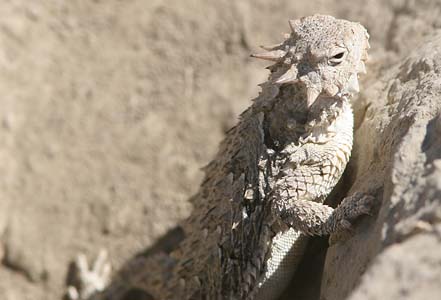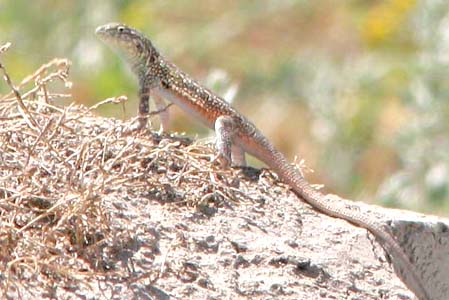
a web page by Don Roberson |
 Think
of a very hot place. Lots of sun, stunted short dry grass, howling
wind, patches of bare baked sand. That's Pixley National Wildlife
Refuge, Tulare County, California (above). That remote site is one of
the very few places in the world to see the endangered Blunt-nosed Leopard Lizard.
This lizard would be special any time but for a brief time in early
summer, the otherwise sandy-colored male turns into a bright orange
caricature lizard, like a child's toy in its garish pattern. Few see
this incredible brute, perhaps because he lives in the netherworld
below ground most of the time. He emerges to defend his ground, seek
mates, and devour prey during the hottest days of summer. Think
of a very hot place. Lots of sun, stunted short dry grass, howling
wind, patches of bare baked sand. That's Pixley National Wildlife
Refuge, Tulare County, California (above). That remote site is one of
the very few places in the world to see the endangered Blunt-nosed Leopard Lizard.
This lizard would be special any time but for a brief time in early
summer, the otherwise sandy-colored male turns into a bright orange
caricature lizard, like a child's toy in its garish pattern. Few see
this incredible brute, perhaps because he lives in the netherworld
below ground most of the time. He emerges to defend his ground, seek
mates, and devour prey during the hottest days of summer. |
||
 This
is one kick-ass lizard. It is large as California lizards go; it is
wary and very fast (it can even run bipedal if needed); and it is
beautiful. Ordinarily the complex back pattern is exquisite even on the
dullest examples, but these few bright orange males are astonishing. I
had no idea they existed in this color until we encountered one, thanks
to the efforts of Pam Williams & Steve Laymon, wildlife biologists
studying the vertebrates of Pixley. It was the most impressive lizard
I've seen in California. This
is one kick-ass lizard. It is large as California lizards go; it is
wary and very fast (it can even run bipedal if needed); and it is
beautiful. Ordinarily the complex back pattern is exquisite even on the
dullest examples, but these few bright orange males are astonishing. I
had no idea they existed in this color until we encountered one, thanks
to the efforts of Pam Williams & Steve Laymon, wildlife biologists
studying the vertebrates of Pixley. It was the most impressive lizard
I've seen in California. |
||
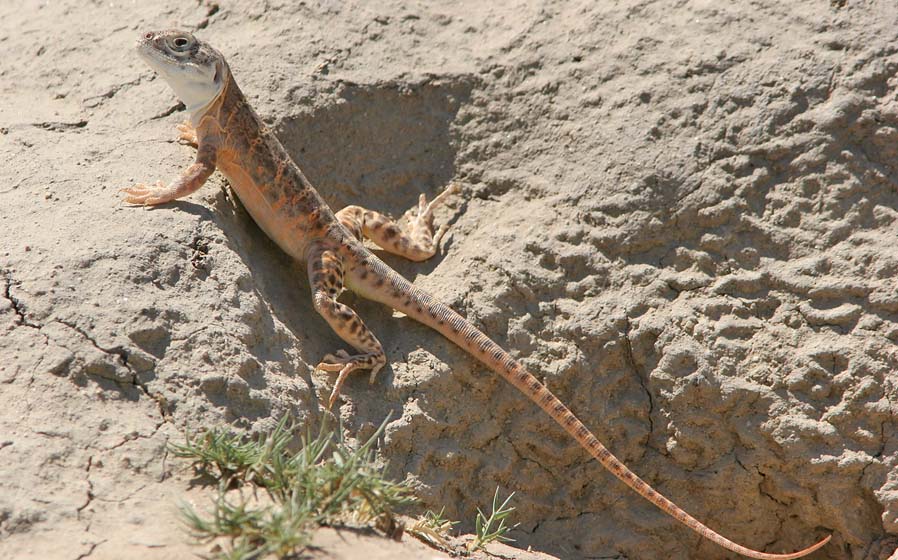 |
||
 |
||
Blunt-nosed Leopard Lizard's color patterns are adapted to their habitats, and over the species' range in California there is wide variation within the paler to darker continuum. Many examples of this can be seen on Gary Nafis's great website on California herps. Blunt-nosed Leopard Lizard is a California endemic. It was once widespread across the San Joaquin Valley but most of its habitat has been developed to agriculture and only isolated fragments remain. There is no population estimate, but a multi-year study on the Elkorn Plain (a stronghold) recorded 1078 lizards during their project (Germano & Williams 2005). The worldwide population may not be much higher. Many of the fragmented populations no longer have corridors of access to other populations, and one wonders about the eventual genetic effect of in-breeding. There is also concern about the impact of global warming on this and other lizards that require a specific temperature zone for foraging. Blunt-nosed Leopard Lizards require rodent burrows for shade and predator protection. During the summer they are never far from a burrow, and in the winter they spend half-a-year underground. At Pixley NWR those burrows are provided by California Ground-Squirrels and Heermann's Kangaroo-Rats. We also encountered two other lizard species using burrows on the refuge: Coast (Blainville's) Horned Lizard Phrynosoma blainvillii (=Anota coronatum; below left; see fn1) and Common Side-blotched Lizard Uta stansburiana (below right). |
||
|
||
|
||
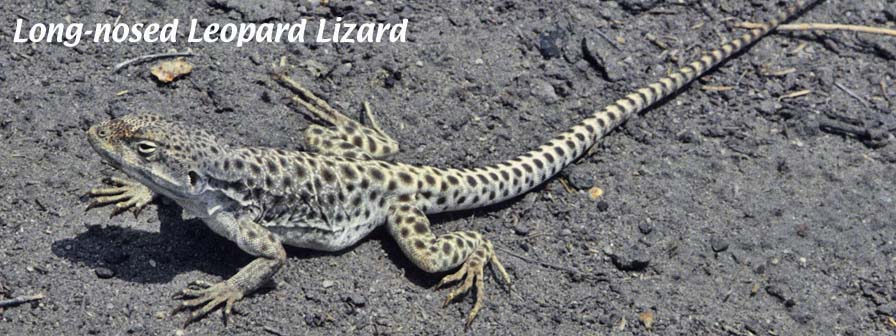 |
||
 |
||
|
||
 |
||
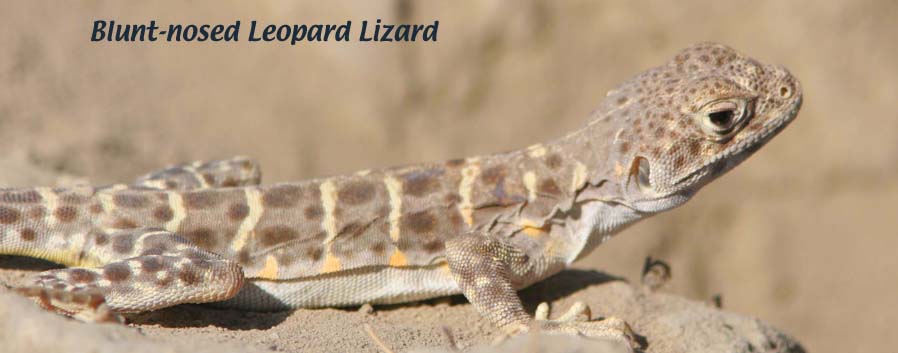 |
||
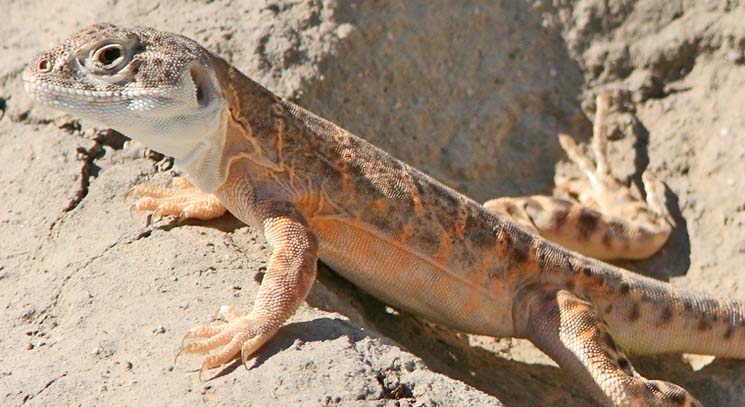 Long-nosed
Leopard Lizard was my favorite California lizard before I visited
Pixley. Rita and I had seen a Blunt-nosed in the Kettleman Hills of w.
Fresno County, back in April 1991, but that lizard was not in breeding
condition. Seeing this one at Pixley was a superb event. Given the
beauty and cockiness of this male, and recognizing its status as
Endangered and difficult to find, Blunt-nosed Leopard Lizard is now my
choice for "California's best lizard." Long-nosed
Leopard Lizard was my favorite California lizard before I visited
Pixley. Rita and I had seen a Blunt-nosed in the Kettleman Hills of w.
Fresno County, back in April 1991, but that lizard was not in breeding
condition. Seeing this one at Pixley was a superb event. Given the
beauty and cockiness of this male, and recognizing its status as
Endangered and difficult to find, Blunt-nosed Leopard Lizard is now my
choice for "California's best lizard." |
||
|
||
 |
||
Photos: All photos of Blunt-nosed Leopard Lizard were taken 13 June 2010 at Pixley NWR, Tulare Co., California [as were the horned lizaed & side-blotched lizard]. The first Long-nosed Leopard Lizard was photographed at Big Sandy Spring, Death Valley NP, Inyo Co., in June 1987. The gravid female Long-nosed Leopard Lizard was photographed at Saline Valley, Death Valley NP, Inyo Co., on 27 May 1978. All photos © Don Roberson, all rights reserved. Literature cited:
footnote 1: regarding Coast Horned Lizard — some recent research suggests that the population in Baja California is distinct and it bears the nominate name, cononatus, making our lizard blainvillii ("Blainville's Horned Lizard). There is also a proposal to change the genus, which gives us Phrynosoma blainvillii for our lizard, which had been known as Anota coronatum. The official lists have not yet sorted this all out. |
||
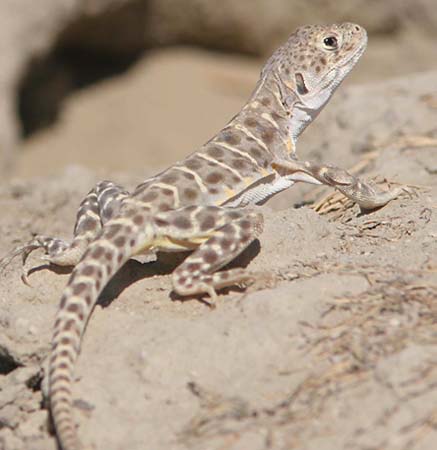 Blunt-nosed Leopard Lizard Gambelia sila
is one of three species of Leopard Lizard in n. Mexico and sw. United
States, and one of a dozen species in the family Crotaphytidae
[collared & leopard lizards]. All are fast, agile, long-limbed and
long-tailed carnivores, dining primarily on smaller lizards and
grasshoppers. When first encountered above ground, these leopard
lizards held a pose with tail raised in an arch (above), as if ready to
run at an instant. These are two different individuals (above &
left) showing the typical pattern when not in full breeding condition.
Small yellow blotches on the sides suggest immaturity (Pam Williams, in
litt.). The dorsal pattern is a complex mosaic of spots, interspersed
with pale cross-bars on the back. The back pattern reminds me of the
dorsal pattern on the huge
Blunt-nosed Leopard Lizard Gambelia sila
is one of three species of Leopard Lizard in n. Mexico and sw. United
States, and one of a dozen species in the family Crotaphytidae
[collared & leopard lizards]. All are fast, agile, long-limbed and
long-tailed carnivores, dining primarily on smaller lizards and
grasshoppers. When first encountered above ground, these leopard
lizards held a pose with tail raised in an arch (above), as if ready to
run at an instant. These are two different individuals (above &
left) showing the typical pattern when not in full breeding condition.
Small yellow blotches on the sides suggest immaturity (Pam Williams, in
litt.). The dorsal pattern is a complex mosaic of spots, interspersed
with pale cross-bars on the back. The back pattern reminds me of the
dorsal pattern on the huge 